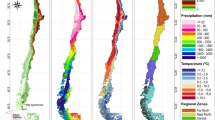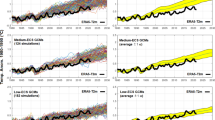Abstract.
This study considers an ensemble of six 10-year climate simulations conducted with the Canadian Climate Centre 2nd generation General Circulation Model (CCC GCM2). Each simulation was forced according to the Atmospheric Model Intercomparison Project (AMIP) experimental protocol using monthly mean sea surface temperatures and sea-ice extents based on observations for January, 1979 to December 1988. One simulation, conducted on a CRAY computer, was initiated from analysed 1 January 1979 conditions while the remaining 5 simulations, conducted on a NEC computer, were initiated from previously simulated model states obtained from a long control integration. The interannual variability and potential predictability of simulated and observed 500 hPa geopotential, 850 hPa temperature and 300 hPa stream function are examined and inter-compared using statistical analysis of variance techniques to partition variance into a number of components. The boundary conditions specified by AMIP are found to induce statistically significant amounts of predictable variance on the interannual time scale in the tropics and, to a lesser extent, at extratropical latitudes. In addition, local interactions between the atmosphere and the land surface apparently induce significant amounts of potentially predictable interannual variance in the tropical lower atmosphere and also at some locations in the temperate lower atmosphere. No evidence was found that the atmosphere's internal dynamics on their own generate potentially predictable variations on the interannual time scale. The sensitivity of the statistical methods used is demonstrated by the fact that we are able to detect differences between the climates simulated on the two computers used. The causes of these physically insignificant changes are traced. The statistical procedures are checked by confirming that the choice of initial conditions does not lead to significant inter-simulation variation. The simulations are also interpreted as an ensemble of climate forecasts that rely only on the specified boundary conditions for their predictive skill. The forecasts are verified against observations and against themselves. In agreement with other studies it was found that the forecasts have very high skill in the tropics and moderate skill in the extratropics.
Similar content being viewed by others
Author information
Authors and Affiliations
Additional information
Received: 18 December 1995 / Accepted: 4 April 1996
Rights and permissions
About this article
Cite this article
Zwiers, F. Interannual variability and predictability in an ensemble of AMIP climate simulations conducted with the CCC GCM2. Climate Dynamics 12, 825–847 (1996). https://doi.org/10.1007/s003820050146
Issue Date:
DOI: https://doi.org/10.1007/s003820050146




